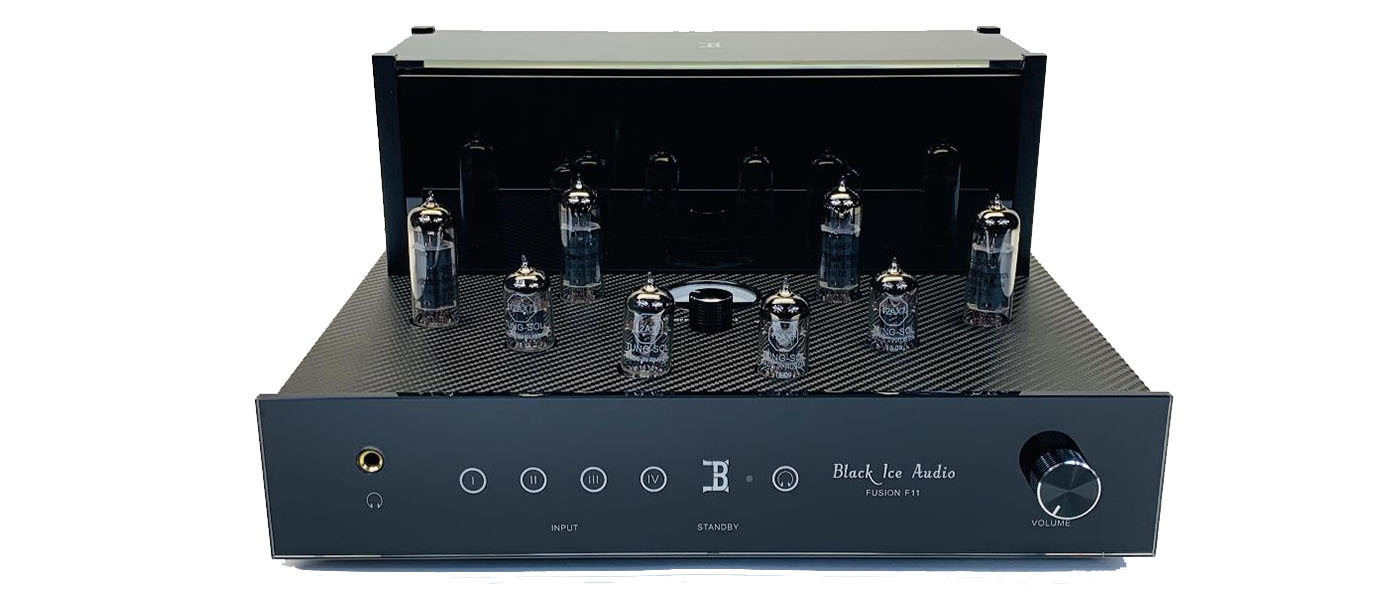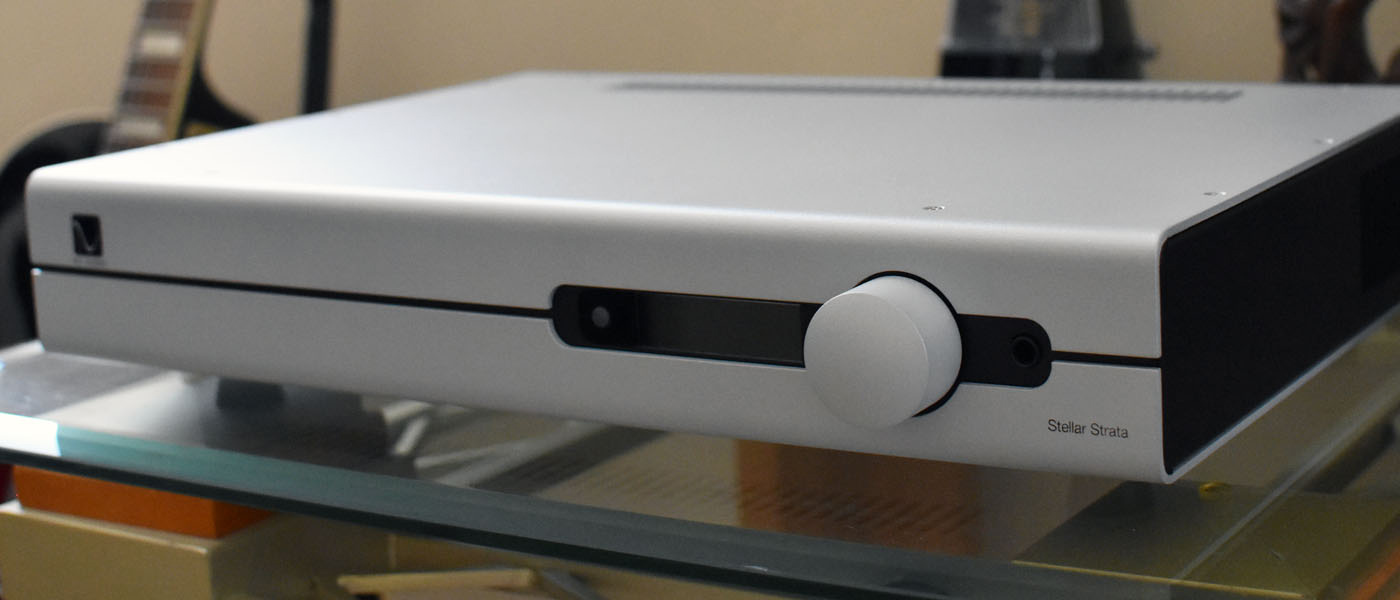
Appearance-wise, the Stellar Strata integrated amplifier closely resembles the Stellar GainCell Preamp/DAC, which I reviewed not too long ago. The difference is only noticeable when looking at the rear panel of the unit, with the presence of the speaker-output terminals on the Strata. The Stellar Strata is more than just a traditional integrated amplifier. It combines a full-featured analog preamplifier, DAC, streaming module, and stereo power amplifier in one chassis. The DAC in the Strata is based on the 32-bit ESS Sabre Hyperstream architecture, which is capable of processing both PCM (through all its digital inputs, up to 24-bit/384-kHz) and DSD signals (through its I2S and USB inputs, up to 5.6 Mbps). The Strata also includes a streaming module (called the Bridge), which can be connected to the internet via Ethernet or 2.4 GHz WiFi, capable of streaming up to 96 kHz music files. The Bridge can be controlled using the PS Audio Connect app, which can also be used to access popular streaming services, such as Tidal, Qobuz, and Spotify. The versatility of the Stellar Strata does not end there, as it also includes an onboard analog headphone amplifier. The Stellar Strata has a price tag of $2,999.

PS Audio Stellar Strata Integrated Amplifier
- An integrated amplifier with DAC functionality in one chassis.
- DAC can handle both PCM (up to 24-bit/384-kHz) and DSD music signals (through its I2S and USB inputs, up to 5.6 MHz).
- Network streaming feature.
- Understated looks with excellent build quality and finish.
Not too long ago, I favorably reviewed the GainCell Preamp/DAC (GCD) from the PS Audio Stellar line. The GCD is easy to like as it offers versatility and performance that is hard to beat in its price range. In July 2020, PS Audio released a new product into the Stellar line, called the Strata, which is a modern integrated amplifier. The ‘modern’ classification is to indicate that the Strata has an onboard DAC and hence, it can handle digital signals on top of its traditional analog integrated functions.
Secrets Sponsor
It is natural to think that the Strata was the result of the PS Audio effort in combining the GCD and the S300 amplifier into one chassis. After all, their specifications are relatively close. But Paul McGowan, the CEO and founder of the company, indicated to me that the Strata was more than just the sum of the two products. It has improvements in various parts of the product and it also adds a streaming feature, which is not in the GCD. Let us see in more detail what this $2,999 integrated amplifier brings to the table.
Analog inputs
RCA:
3 stereo pair
XLR:
1 stereo pair
Digital audio inputs
I2S:
1 PCM (384KHz max), DSD64, DSD128
Coax:
2 PCM (192KHz max)
Optical:
1 PCM (96KHz max)
USB:
PCM (384KHz max)
DSD64 (DoP) DSD128 (DoP)
Network:
Wired, 10/100MBPS
1 WIFI, 2.4GHz 802.11b/g/n
UPnP, Spotify Connect
Analog Audio Outputs
RCA Headphones Speakers:
(Analog Unbalanced) 1 stereo pair
One 1/4″ headphone connector
Binding Posts
Analog Performance
Gain:
12dB +/-0.5dB
Input Impedance:
47KΩ single-ended RCA,100KΩ Balanced XLR
Output Impedance:
100Ω single-ended RCA
Frequency Response:
20Hz – 20KHz +0/- 0.25dB, 10Hz – 100KHz +0.1/-3.0dB
S/N Ratio:
1KHz >110dB (max output)
Channel separation:
1KHz >90dB
THD&IM:
1KHz < 0.025%, 20-20KHz < 0.05%
Headphone performance
Output power @1% THD:
300Ω 300mW, 16Ω 3.25W
S/N Ratio 1kHz:
>95dB (max output)
THD & IM 1Vrms out:
300Ω <0.05%, 16Ω <0.06%
Output impedance:
<4 Ω
Power Amplifier Performance
Gain (relative to line output):
30.5dB
Output Power:
8Ω, 1KHz, 1% 120W or 4Ω, 1KHz, 1% 150W typical (per channel)
Frequency Response:
+/-1dB 20Hz – 20KHz, -3dB 7Hz – 40KHz
THD+N:
1KHz, 10W/4Ω 0.02%
Speaker Impedance:
4Ω minimum
Channel Separation:
1KHz >90dB
General
Unit Weight:
21 lbs [9.5 kg]
Unit Dimensions:
17” x 12” x 3”
Power Consumption:
20W idle, 50W typical, 600W Maximum
MSRP:
$ 2,999
Website:
Company Directory:
SECRETS Tags:
PS Audio, PS Audio Stellar Strata Integrated Amplifier, Integrated Amplifier, Amplifier, Integrated Amplifier Review, Review 2020
Just like all other products in the PS Audio Stellar series, the Strata comes in matte silver or black finish. As can be seen from the pictures, my review sample had the silver finish. Except for the Stellar Strata labeling, the front appearance of the unit is pretty much hard to differentiate from the Gain Cell preamp/DAC. It is clean and uncluttered with only the round volume-control knob, the LED display, the input selector/setup button, the 1/4” headphone jack, and the PS Audio square logo button (which also serves as the standby/on button) occupying the front panel. The Strata looks slim with its full-width (17”) aluminum chassis and low height profile but lifting it, you will know that it has hefty innards. Overall, the simplicity of the Strata front-panel design gives it an overall modern and elegant look. The quality of the craftsmanship of the Strata is excellent overall.
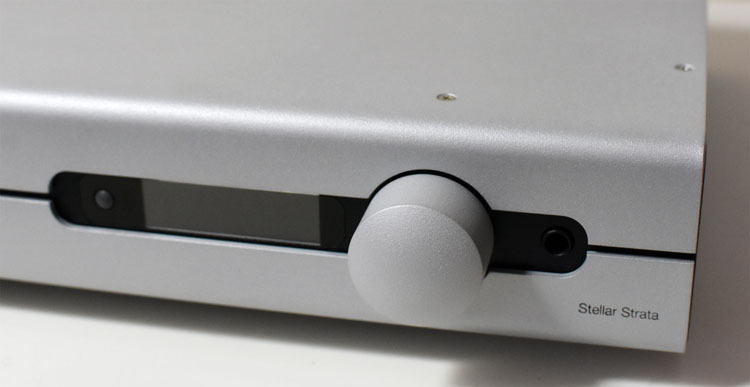
The blue LED display of the Strata is sufficiently bright although I think it can use a larger landscape. It displays volume level in relatively large digits, which can easily be read from 8 ft away, and other information in much smaller digits, such as the input name, DAC filter, the type of signal (PCM or DSD), and the DAC sampling rate. Although this display is similar to the one in the GCD, it shows volume level and other information in smaller digits. It is used to display more information too than in the GCD; for example, in the Stream mode, the display shows the artist name and the track title being played. But the lettering in this case is too small to read, even from 3 ft away. The display brightness is adjustable (on a 1-10 scale) from inside the setup menu. It can also be turned on or off from the remote. Its half brightness setting was sufficient for me and I usually engaged the ‘Auto’ feature, which turns on the display for a few seconds if it detects a change in the incoming signal and off otherwise.

The plethora of input/output connectors on the Strata’s rear panel gives an indication of its versatility. Although the Strata has ample input/output connectors, its rear panel does not look overly crowded and these connectors are nicely laid out. There are three unbalanced analog line-level inputs as well as one balanced XLR input. The volume level of one of the analog inputs (Input 3) can be set fixed for passthrough input, which is an essential feature for home-theater integration. The level of the fixed volume is adjustable to any level within 100 scale. Besides speaker-level outputs, the Strata also provides a pair of unbalanced analog line-level outputs, which can be used for connecting subwoofer(s) or for driving an external power amplifier. Two DC trigger outputs are provided. The Strata has Wi-Fi connection capability, but it also has LAN input for wired network connection.
The digital inputs of the Strata include one I2S, two S/PDIF coax, one optical, and one USB. The inclusion of the I2S connector is desirable as this connector represents the purest signal path for digital signal processing. The I2S input keeps the separate clocks and data content in their parallel form, which is the native form required by the DAC to process, hence skipping the data combining and separating process used in the other connection methods. However, the provision of such digital data output and the connector used is not yet standardized, and thus it can only be used with the digital source components that output I2S data using an HDMI connection. Although the DAC section of the Strata, which is based on the 32-bit ESS Sabre Hyperstream architecture, can handle up to 384-kHz PCM and 5.6-MHz DSD (DSD128) signals, the signal transfer capabilities of these various digital inputs vary depending on the connection type. Only the I2S and USB inputs are able to process the DSD signals, while the others can only process the PCM signals. The coax input can handle up to 192-kHz data rate, while the optical input can handle only up to 96-kHz signals.
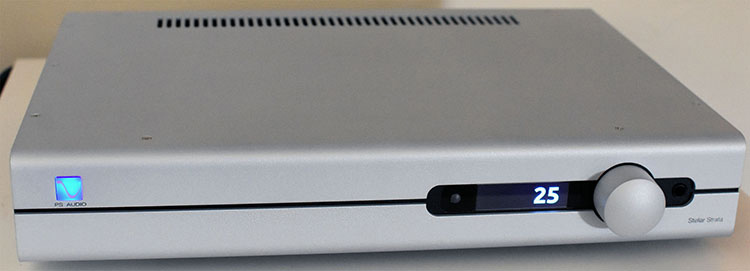
Analog GainCell, which is a method developed by Paul McGowan to control volume by varying the gains, is still at the heart of the Strata. The GainCell controls volume without additional circuitry in the signal path, and hence it can eliminate sonic degradation problems associated with a typical volume control. The proprietary DAC technology called the Digital Lens, which is used to uncover the sample rate and format, re-clock all incoming data, reduce jitter, and reshape the data output to the DAC chip, is also included in the Strata. The Digital Lens technology makes the signal purer with less noise/errors in the effort to generate more accurate digital music reproduction.
The Strata also includes a built-in streamer, which makes it a truly integrated product. Connection to the home network can be done through Wi-Fi or an Ethernet connection. This streaming feature can be controlled using the PS Audio Connect app, which is available for iOS and Android devices. When in streaming mode, the Strata can handle digital signals with sample rates up to 96 kHz. But during my evaluation, I often got stuttering playback when streaming at 96 kHz using Wi-Fi. When it first happened, I thought it was due to the problem with my Wi-Fi connection speed. But I ruled it out quickly after I checked my Wi-Fi connection speed (I have a 300 Mbps broadband network at home), which turned out to be fine, and that the Auralic Aries G1 streamer next to it was capable of streaming at even higher sampling rates with no issue. I consulted PS Audio on this, and the info that I got from the engineering team was that the Bridge module inside the Strata was sensitive to the distance from the Wi-Fi router. This seemed to be the case in my situation as my router is located several rooms away from my audio system. Limiting the streaming sampling rates to CD quality (44.1 kHz) on the PS Audio Connect app solved the issue. I found that the streaming quality at the CD rates was good enough so I did not miss a beat in switching off the 96-kHz streaming option.
The Strata may look slim, but it packs quite a beefy Class-D power amplifier internally, capable of delivering 120 Watts into an 8-Ω load (1 kHz, 1% THD) or 150 Watts into 4-Ω loads. It is specified for use with speakers with a minimum impedance of 4 Ω. With its amplifier power, the Strata should have no issue to drive and control most speakers, except for a few that have their impedance averages drop to lower than 4 ohms.
The infrared remote control supplied with the Strata is the same as the one for the GCD. It is relatively small, but its buttons are good sized, so I felt it was quite comfortable to use. The remote can be used to switch on/standby the device, select the input, adjust the volume level or mute the sound, select the filter or phase for the digital playback, and dim/un-dim the LED display.
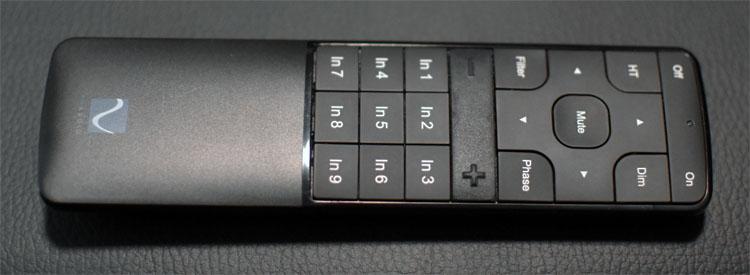
The PS Audio Stellar Strata is designed to simplify one’s hi-fi system setup, the idea being to address the “just add speakers” demand with no sonic compromise. The simplifying aspect is obvious; a single-box Strata can replace multiple boxes of separate audio components consisting of a preamplifier, DAC, network streamer, headphone amplifier, and power amplifier. The question remains whether PS Audio can pull off the “no sonic compromise” goal from this integrated design. In the latter part of this section, I will try to address this very question from my impressions on listening to the product extensively.
Being an all-in-one integrated product, setting up the Strata was a relatively easy endeavor. The Strata comes with a nicely written manual, which is useful to understand some of its more advanced functions, but most probably you will not need it just to get the unit up and running. The initial setup simply involves plugging in the external sources to the appropriate inputs and connecting the speaker outputs to the speakers. Then, just supply power to the unit and switch it on to start enjoying the music. Further customization can be performed by accessing the setup mode, which can be done by long-pressing the input-selector button next to the LED display. The setup menu structure is overall quite intuitive. Balance adjustment, phase setting, maximum analog and headphone volume limits, input name editing, home-theater bypass setup, DC trigger delay, network setup, and DAC mode setting can be performed within the setup mode.
During most of the review, the Strata was used to drive my Revel Ultima Studio tower speakers. The PS Audio PerfectWave DAC II was used to provide analog signals to the Strata, while the Auralic Aries G1 streamer and the PS Audio PerfectWave CD Transport served as the digital sources (feeding both the Strata and the PerfectWave DAC II). The PerfectWave Transport was connected through the I2S connection to the Strata, while the Aries G1 streamer was connected through the coax and USB inputs.
I found the Strata to be quite robust operationally. In digital playback, it never failed to swiftly lock-in and play the digital signals fed through it. Using its USB input, high-resolution PCM signals up to 384 kHz and DSD signals up to 5.6 MHz (DSD128) were processed reliably. Even in streaming mode (Bridge), I found that the Strata worked well, although a bit sluggish in buffering tracks in comparison to a specialty streaming device like the Auralic Aries G1. This might be attributed to the smaller buffer capacity of the Strata’s Bridge as compared to the Aries G1. The PS Audio Connect streaming app was quite easy to use and it had an appealing interface. It had only basic streaming control functions, but it was quite sufficient for streaming control of the Strata.
The Strata is equipped with three selectable digital filters, which differ in how sharp the filter roll-off is and how much ringing results. These are explained in good detail in the manual. Filter 1 is called Fast Roll-off Linear Phase, which has a very good high-frequency response but exhibits a pre-ringing. Filter 2 is a Slow Roll-off Linear Phase Filter, which has the slowest roll-off (hence less-extended highs) with the least amount of ringing. Filter 3 is a Fast Roll-off Minimum Phase Filter, which has a more extended high-frequency response but with more ringing. The differences among these filters are often subtle and might become obvious only on certain parts of musical tracks. I could live with any of these filters, although after a long back-and-forth evaluation, I tended to settle on Filter 3. Your sonic preference might dictate this selection.
Secrets Sponsor
When I first listened to the Strata critically, I was immediately impressed by its refined musical sonic quality with a touch of warmth that was very seductive. I felt that I was drawn into the music more when listening through the Strata and tended to want to listen longer. Also, the Strata’s ability to throw a wide and deep soundstage could definitely compete with the best in the class. These sonic traits were consistent regardless of the input used, be it analog, digital, or streaming. Although from the same PS Audio Stellar family, I did not recall getting the above sonic characteristics from the GCD paired with various respectable amplifiers that I had during the review (Bel Canto Ref500S, Parasound A23+, or PS Audio HCA2). Not sure if I would get a similar sonic performance if I paired the GCD with any of the PS Audio’s own Stellar amplifiers as I did not have one for the review. But regardless, the Strata’s sonic excellence shows that PS Audio has done its due diligence in tuning and matching the subcomponents inside the Strata to achieve the desired voicing. Hence, besides convenience, with a carefully-engineered integrated product like the Strata, you get the “best performance” right out of the box, saving headaches of finding matched components for yourself like when dealing with separates.

Blue Rodeo, Five Days in July, (1993)
The musicality of the Strata was in full display in the rendition of the track Dark Angel by Blue Rodeo from the album Five Days in July (1993). Sarah McLachlan was featured in this track and the harmony between the male vocalist from the group and Sarah’s voice was presented beautifully by the Strata. The fullness and the naturality of the vocals were nothing short of excellent. The sound of the accompanying piano, including the transients from the attack of the piano keys, was realistic and full of texture, enhancing the feeling of being there.

Dave Brubeck, On Time, (2001)
The ability of the Strata to image and deliver a wide and deep soundstage is exemplified very well by the track Besame Mucho as performed by Dave Brubeck from the album On Time (2001). The sense of space with the steady image of the musicians playing various instruments in the music was portrayed with great realism through the Strata. The image focus on the individual instruments was steady and on-point. Each instrument was portrayed to occupy unmistakable locations in the spacious sound stage with good separation from the other instruments.
This track also demonstrates the Strata’s ability to handle the dynamics in the music, even to the micro-dynamics level. It never lost the presentation of details in navigating through the peak and valley of the music. The balance across the frequency spectrum was excellent. The music was presented with solid and full mid-range, detailed and airy treble, and articulate bass with good extension. The Strata might not produce the punchiest and most extended bass through the Ultima Studio speakers, but I felt the bass produced was always controlled and had sufficient relative levels to balance the rest of the frequency spectrum. Most of Dave Brubeck’s recording could sound rather lean on some systems, but not when played through the Strata. And that touch of warmth in the Strata’s sonic character was especially very appealing to me.
In whatever capacity within its range of functions, the Strata, in general, performs admirably. There does not seem to be any obvious weaknesses in what the Strata does. The Strata may not be the best in all aspects of its functions, but it sure does extremely well in all of them. Even as a headphone amplifier, which I considered as little more than a feature of convenience, the Strata performed remarkably well. I was quite impressed by the clarity, details, and naturality of the music I listened to using headphones through the Strata. The onboard Class D amplifier of the Strata did not have any issues in driving the moderate loads presented by the Ultima Studio speakers. Even when pushed to relatively high volume levels (higher than my typical listening levels), I did not notice a loss of control or any straining of the reproduced music, showing that it had enough headroom to handle most normal listening situations.
The PS Audio Stellar Strata integrated amplifier is a versatile product with features and sonic performance that represent significant value at its price tag.
- Simple but handsome looking appearance
- Solid build quality
- Handles both analog and digital signals
- DAC is capable of up to 384 kHz PCM and 5.6 MHz DSD signals
- Streaming feature with an easy-to-use streaming control app
- A sufficiently powerful onboard amplifier
- Sonic performance that can beat separates in its price range
- None
The PS Audio Strata modern integrated amplifier is a solid and versatile audio component that can playback analog and digital signals adeptly. With its up-to-date onboard DAC, which is capable of handling high-resolution PCM and DSD signals, and its network streaming feature, the Strata is truly an integrated component that eliminates the need for separate DAC and music-streaming devices in one’s system. While it is true that separates offer flexibility to mix and match various components (and cables) to get to the sought-after sonic performance, they also tend to be more costly and require some matching effort. Nothing beats the convenience of an integrated component, and the Strata also demonstrates that this convenience does not have to come with sonic-performance compromise. In fact, the Strata is so well-engineered and tuned, in my opinion, it can deliver the sonic performances that can beat those of separates in a similar price range. With its strong all-around performance, the Stellar Strata integrated amplifier brings a lot of value that is hard to beat at its asking price. For people who want simplicity and convenience in their hi-fi stereo systems without sacrificing performance, the PS Audio Stellar Strata is a must audition.


